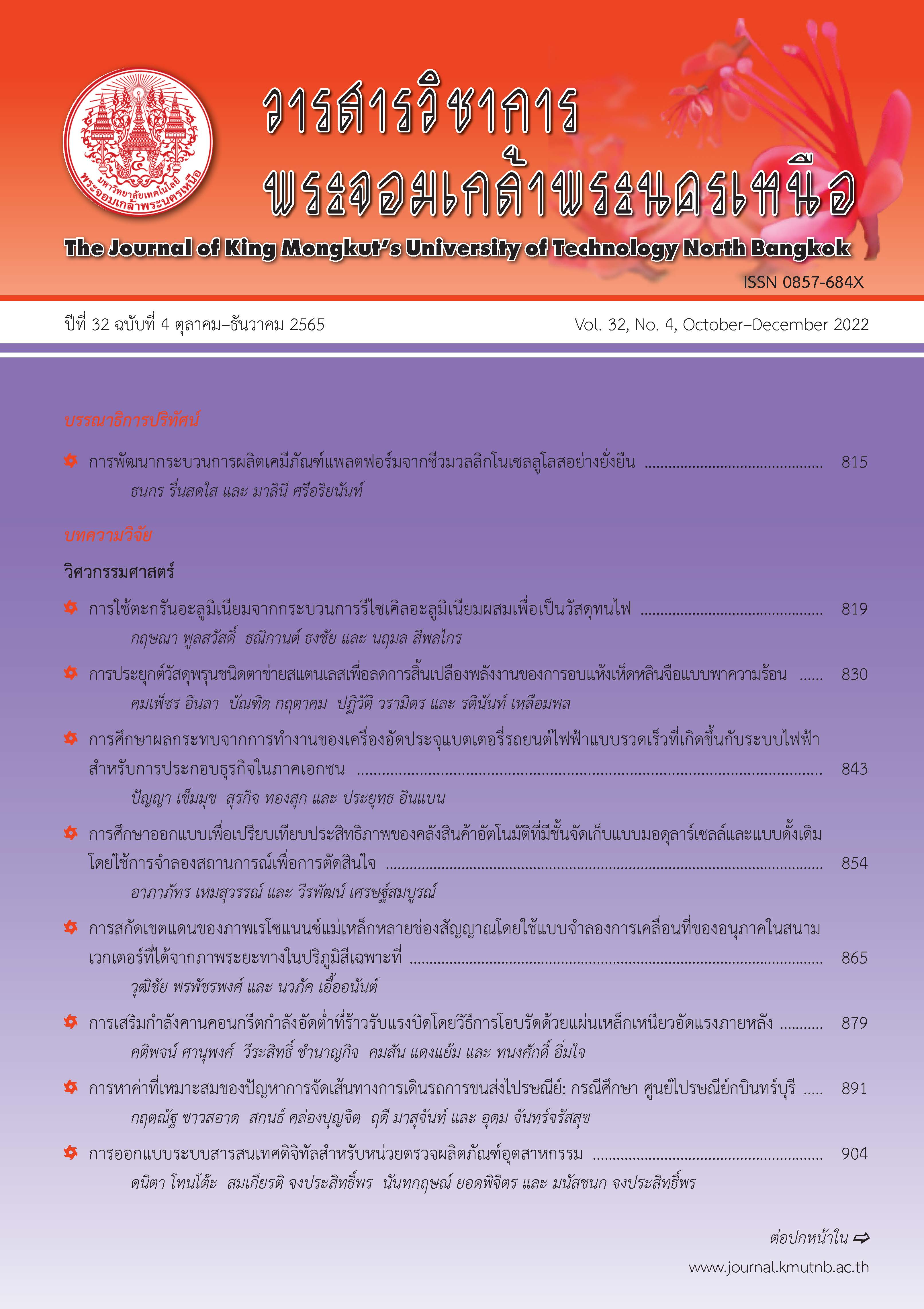ผลกระทบของการใช้ถ่านชีวภาพต่อการรอดชีวิต และการเจริญเติบโตของไส้เดือนดินพันธุ์ African night crawler (Eudrilus eugeniae)
Main Article Content
บทคัดย่อ
การผลิตเกษตรอินทรีย์โดยใช้ทรัพยากรที่มีในชุมชนให้เกิดประโยชน์ เช่น การใช้ถ่านชีวภาพซึ่งมีคุณสมบัติช่วยในการปรับปรุงคุณภาพดิน และมีผลต่อการเจริญเติบโตของพืชและสิ่งมีชีวิตในดิน โดยเฉพาะไส้เดือนดินซึ่งงานวิจัยนี้จึงมีวัตถุประสงค์เพื่อศึกษาผลกระทบของถ่านชีวภาพแต่ละชนิดต่อการรอดชีวิต และการเจริญเติบโตของไส้เดือนดินพันธุ์ African night crawler (Eudrilus eugeniae) จำนวน 30 ตัวต่อกรรมวิธี โดยวางแผนการทดลองแบบ CRD ประกอบด้วย 4 กรรมวิธี จำนวน 4 ซ้ำ ดังนี้ 1) มูลวัว 2) มูลวัว+ถ่านแกลบ 3) มูลวัว+ถ่านฟางข้าว และ 4) มูลวัว+ถ่านกระดูกหมู ผลการศึกษา พบว่า การเจริญเติบโตของไส้เดือนพันธุ์ African night crawler เริ่มมีการตายตั้งแต่สัปดาห์ที่ 1 หลังการเพาะเลี้ยง โดยอัตราการรอดชีวิต และการเจริญเติบโตตลอดระยเวลาการศึกษา 6 สัปดาห์ของการเพาะเลี้ยง พบว่า ในกรรมวิธีที่ใส่มูลวัว+ถ่านฟางข้าว มีจำนวนไส้เดือนที่รอดสูงสุด 21 ตัว คิดเป็นอัตราการรอด เท่ากับ 71 เปอร์เซ็นต์ ซึ่งสูงกว่ากรรมวิธีมูลวัวอย่างเดียว (15 ตัว คิดเป็นอัตราการรอด เท่ากับ 48 เปอร์เซ็นต์ ตามลำดับ) แต่อย่างไรก็ตาม เจริญเติบโตของไส้เดือนดินไม่แตกต่างกันทางสถิติเมื่อเทียบกับการใส่มูลวัวอย่างเดียว ในขณะที่กรรมวิธีมูลวัว+ถ่านกระดูกหมู พบว่า อัตราการรอดชีวิต และการเจริญเติบโตของไส้เดือนต่ำที่สุด ดังนั้น การใช้ถ่านฟางข้าวร่วมกับมูลวัวในสัดส่วน 1:1 ในการเพาะเลี้ยงไส้เดือนดิน พันธุ์ African night crawler ช่วยให้ไส้เดือนมีการรอดชีวิต และการเจริญเติบโตดีที่สุดเมื่อเปรียบเทียบกับถ่านชีวภาพชนิดอื่นๆ
Article Details

อนุญาตภายใต้เงื่อนไข Creative Commons Attribution-NonCommercial-NoDerivatives 4.0 International License.
บทความที่ลงตีพิมพ์เป็นข้อคิดเห็นของผู้เขียนเท่านั้น
ผู้เขียนจะต้องเป็นผู้รับผิดชอบต่อผลทางกฎหมายใดๆ ที่อาจเกิดขึ้นจากบทความนั้น
เอกสารอ้างอิง
S. Hemwong, “Effects of bamboo and rice husk biochars on yield and nitrogen use efficiency of Chainat 1 rice variety,” Journal of Science and Technology, Ubon Ratchathani University, vol. 16, no. 1, pp. 69–75, 2014 (in Thai).
Food and Fertilizer Technology Center. (2001). Application of Rice Husk Charcoal. FFTC. Taipei, Taiwan. [Online]. Available: https://www.fftc. org.tw/htmlarea_file/library/20110716181529/ pt2001004.pdf
W. H. Elmer and J. J. Pignatello, “Effect of biochar amendment on arbuscular mycorrhizae and Fusarium crown and root rot of asparagus in replant soils,” Plant Disease, vol. 95, pp. 960– 966, 2011.
Y. M. Harel, Y. Elad, D. Rav-David, M. Borenstein, R. Shulchani, B. Lew, and E.R. Graber, “Biochar mediates systemic response of strawberry to foliar fungai pathogens,” Plant and Soil, vol. 100, no.9, pp. 913–920, 2011.
M. Kolton, Y. M. Harel, Z. Pasternak, E. R. Graber, Y. Elad, and E. Cytryn, “Impact of biochar application to soil on the root-associated bacterial community structure of fully developed greenhouse pepper plants,” Applied and Environmental Microbiology, vol. 77, no. 14, pp. 4924–4930, 2011.
J. P. Curry, “Factors affecting the abundance of earthworms in soils,” in Earthworm Ecology, Boca Raton: CRC Press, 2004, pp. 91–114.
A. Tanco, Earthworm. National Science and Technology Development, Phathum Thani, 2007 (in Thai).
S. Hemwong and S. Chualsuna, “Using of charcoal to improve soil fertility for sweet waxy corn production,” Journal of Agriculture, vol. 27, no. 3, pp. 259–266, 2011 (in Thai).
A. M. Liesch, S. L. Weyer, J. W. Gaskin, and K. C. Das, “Impact of two different biochars on earthwarm growth and survival,” Annals of Environmental Science, vol. 4, pp. 1–9, 2010.
J. L. Gomez-Eyles, T. Sizmur, C. D. Collins, and M. E. Hodson, “Effects of biochar and the earthworm Eisenia fetida on the bioavailability of polycyclic aromatic hydrocarbons and potentially toxic elements,” Environmental Pollution, vol. 152, pp. 616–622, 2011.
S. Abel, A. Peters, S. Trinks, H. Schonsky, M. Facklam, and G. Weesolek, “Impact of biochar and hydrochar addition on water retention and water repellency of sandy soil,” Geoderma, vol. 202–203, pp. 183–191, 2013.
P. Tammeorg, T. Parviainen, V. Nuutinen, A. Simojoki, E. Vaara, and J. Helenius, “Effects of biochar on earthworms in arable soil: Avoidance test and field trial in boreal loamy sand,” Agriculture Ecosystem and Environment, vol. 191, pp. 150–157, 2014.
M. Hagner, R. Kemppainen, L. Jauhiainen, K. Tiilikkala, and H. Setälä, “The effects of birch (Betula spp.) biochar and pyrolysis temperature on soil properties and plant growth,” Soil and Tillage Research, vol. 163, pp. 224–234, 2016.
B. Husk and J. Major. (2010, Mar.). Commercial scale agricultural biochar field trial in Québec, Canada over two years: Effects of biochar on soil fertility, biology and crop productivity. Blueleaf Biochar Field Trial. [online]. Available: http://www.Researchgate.net/publication/ 273467636
M. J. Jr Antal and M. Gronli, “The art, science, and technology of charcoal production,” Industrial and Engineering Chemistry Research, vol. 42, no. 8, pp. 1619–1640.

